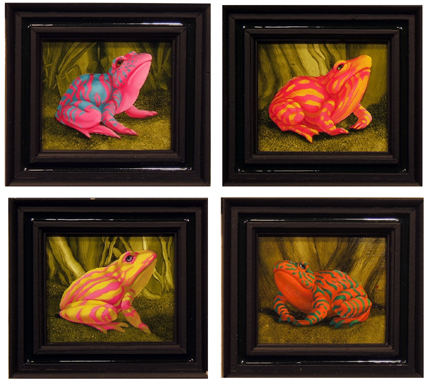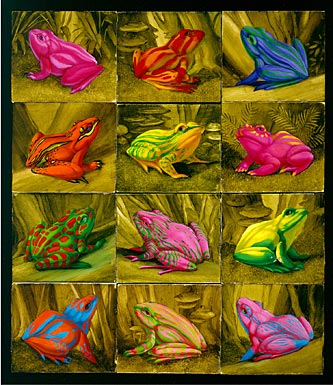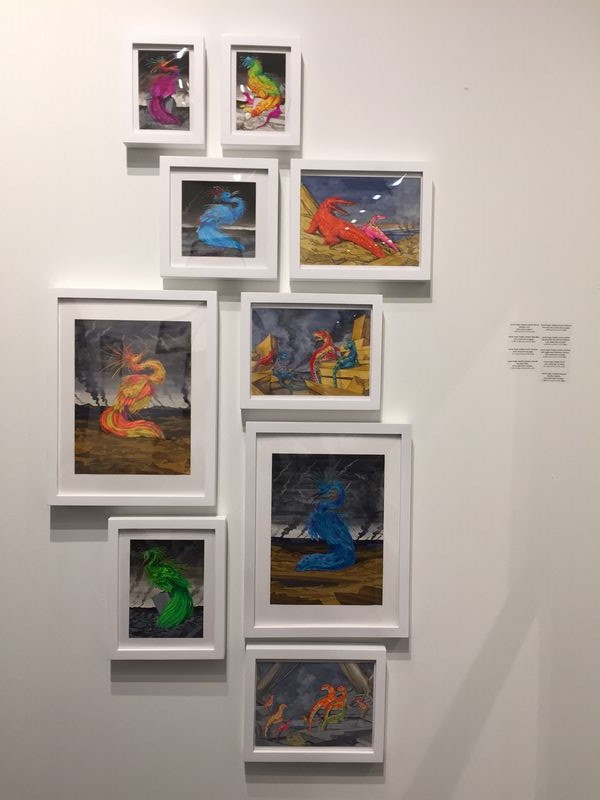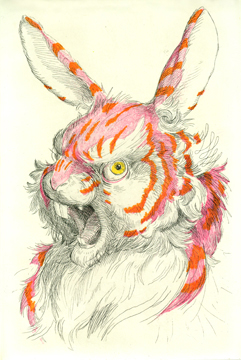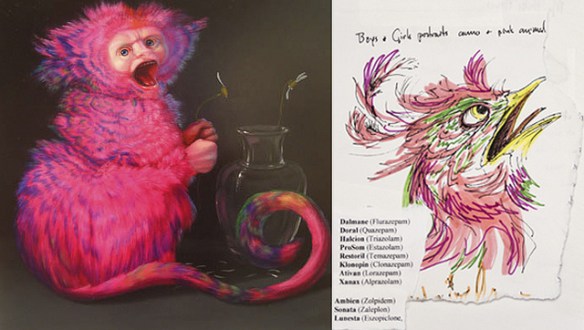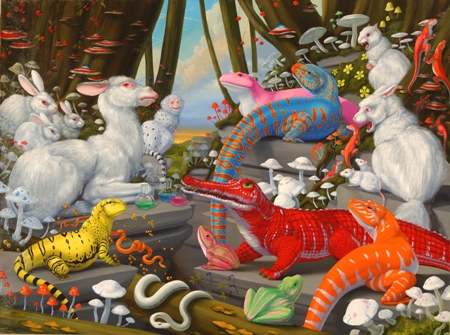LAURIE HOGIN
Paintings
Please click on images for CAPTIONS
Watercolors
Please click on images for CAPTIONS
Prints
Please click on images for CAPTIONS
Sculpture
Please click on images for CAPTIONS
Work by Laurie Hogin ranges from $700-$26,000.
“My work is always influenced by the political and social conditions at the time I am making it and, although the show isn’t directly political in any kind of literal, partisan way, the newer works in this exhibition are influenced by recent developments”
Amygdala Lizard
Laurie Hogin's most recent body of work, Amygdala, refers to an almond-shaped mass located deep within the mammalian brain, although other species, including certain reptiles, appear to have structures with similar function. (1) It is involved in motivation, emotion, and emotional behavior, and is activated by all sensory experiences. (2) It is widely accepted that the amygdala plays a critical role in acquisition and consolidation of emotionally charged memories. Research suggests that emotional memories are formed, in part, through associative learning, (3) wherein a creature's or person's emotions and behaviors are influenced by sensory experiences that cause associations with earlier experiences, even if the current environment is different.
Hogin is interested in how emotionally charged memories become language, symbols and metaphors, and how sensory inputs like color, sound, scent, physical pain, pleasure, or social and emotional context develop latent meanings through naming, categorization, and narrative.
Hogin's topics include love, pleasure, desire, attraction, and attachment, as well as trauma, anger, obsession, addiction, violence, and grief. These aspects of human experience and identity, resultant of the interplay of evolutionary biology and language, all find expression in the schizoid array of material culture, which expresses human cognition, experience, and consciousness.
The paintings combine visual, conceptual and material strategies from the history of representational painting with tropes of contemporary visual culture including cinema, advertising, fashion, pornography, food photography, retail and museum display and other narrative, representational strategies. These strategies evoke stories, memories and associations in order to convey states of being and behaviors common to humans, and arguably observable in other beings as well. Such states represent the inseparability of the emotional, physical, cognitive and psychosocial aspects of lived experience.
The works in this show use traditions in Western painting and other narrative pictorial traditions, as these traditions include established visual languages that express specific modes of thinking and ways of being. They describe emotional responses to the environment, both as sensory experience and as mediated by cultural representations and ideas about nature, especially in the history of pictures, but including poetry, literature, philosophy, politics and science.
Laurie Hogin: “Implacable Demons and Better Angels” at Tory Folliard Gallery
By James Yood, February 22, 2017
“Portrait of a Startled Rabbit Near a Culvert,” 2016, Laurie Hogin, oil on Canvas, 201⁄2″ x 18″ Photo: courtesy of Tory Folliard Gallery
Laurie Hogin’s mutated menageries are simultaneously extremely beautiful and intensely horrific. A bit more the former than the latter, though; this is all as if you took Edward Hicks’ The Peaceable Kingdom (1826) and added to it about 100 years of pesticides, radiation, inbreeding and ecosystem destruction—Hell never looked so gorgeous. Where Hicks posited an animal world at peace with humankind, Hogin sees everywhere a comely corruption, an animal kingdom so giddy in its savagery and evil that only the trappings of an overcharged and hothouse beauty could describe it. Hogin’s animals are so flat-out convincingly evil in their appearance that they almost look human.
Superb realist skills are an important element in this, in her way Hogin is a moralist in a world gone mad, a Cassandra to a world so seduced and distracted by beauty that specificity of representation is crucial. A purposeful nod to art history too is a standard device in her work, a painting such as Portrait of a Startled Rabbit Near a Culvert (2016) is a riff on 18th-century British Portraiture with the complacent country squire as the confident ruler of his rustic domain. That is, if the squire was a crazed rabbit standing amidst overly genetically modified fruits and vegetables. There are more rabbits than any other species on view here, though there are plenty of lizards, peacocks, monkeys, other birds, etc.—which are all overbred and manic as well. But rabbits, whom we usually culturally identify as relatively benign and peaceful creatures with an amiable sensuality and an inherent cuteness in Hogin’s hands become vehicles of deceit, cunning and aggression—more predatory than precious.
Read more here
Best known for her allegorical paintings of mutant plants and animals in languishing, overgrown landscape settings or posed as though for classical still life or portraiture, Laurie Hogin's interests include examining human impulses, desires, and needs, including pleasure, intoxication, addiction, the erotic, totem, violence, greed, grief, and love. These aspects of human experience and identity, resultant of the interplay of evolutionary biology and culture, find expression in the history of visual culture as well as in the nearly schizoid array of cultural material and commodity in contemporary consumer capital. Hogin combines various tropes from the history of painting, natural history and scientific display, pornography, fashion photography and retail display with narrative allegory, often describing political, social, economic, and emotional phenomena.
Hogin's research interests also include cognitive approaches to understanding visual culture and creativity, and the application of theories of propaganda, pictorial narrative and imaginary space to visual materials intended for specific educational purposes. Recent and current projects include the design and implementation of a visually-based nutrition education program for elementary school children, and the design of a program for a community youth service organization to guide teens through the process of setting up a small, sustainable clothing design business. These projects, along with Hogin's ongoing studio practice and exhibition career, inform her teaching.
Hogin's work has been exhibited nationally and internationally for more than 20 years, including the Museum of Contemporary Art, Chicago, IL; the Addison Gallery of American Art, Andover, MA; Contemporary Art Center, New Orleans, LA; Frederick R. Weisman Museum of Art, Malibu, CA; Norton Museum, Palm Beach, FL; Contemporary Arts Center, Cincinnati, OH; Kemper Museum, Kansas City, MO; State of Illinois Museums at Chicago and Springfield, IL; John Michael Kohler Arts Center, Sheboygan, WI; International Print Center of New York; Scottsdale Museum of Contemporary Art, AZ, Museum of Fine Arts, Albuquerque, NM.
artist’s statement
"My work of the past 20 years has consisted primarily of allegorical paintings of mutant plants and animals in languishing, overgrown landscape settings or posed as though for classical still life or portraiture. My current interests include examining human impulses, desires, and needs, including pleasure, intoxication, addiction, the erotic, totem, violence, greed, grief, and love. These aspects of human experience and identity, resultant of the interplay of evolutionary biology and culture, find expression in the history of visual culture as well as in the nearly schizoid array of cultural material and commodity in contemporary consumer capital. I combine various tropes from the history of painting, natural history and scientific display, pornography, fashion photography and retail display with narrative allegory, often describing political, social, economic, and emotional phenomena.
Blue Monkey-The diagnosis Will Not Be Televised, 2014, oil on panel, 15x15
Narratives and stories—from fiction, myth, doctrine, and propaganda, to news items, ad slogans and song lyrics—articulate human experiences. Our current cultural context is one in which free markets promise stories, experiences, images and commodities to fill every conceivable human need and desire, from the most basic to the weirdest and darkest. Recent works are a combination of personal narrative and cultural comment that describe how I am an example of a contemporary individual negotiating the world as she recognizes and copes with the impulses inherent in her own humanity.
My paintings that range in size from the near-heroic to the diminutive. They take their window-like compositions from natural history dioramas and Western landscape, still life, and portraiture, combining visual strategies from the history of painting with contemporary visual conventions. Species are chosen for their allegorical associations in Western culture, but are depicted as degraded or mutant versions: They are the Day-Glo colors of contemporary media landscapes; their morphology resembles toys and cartoons as much as naturalistic specimens. The plants, animals, and objects depicted are the colors of our globalized economy, from the day-glo hues of big-box store commodities to the pixilated palettes of television and the Internet, as well as the colors of nationalist identity and political affiliation. Plant vines sprout berries that arrange themselves as psychoactive molecules and mushroom caps display emotional slogans; the landscape becomes an imagined nature’s literal embodiment of contemporary expressions of human desire and need.
Certainly, as a painter, I value the visual, tactile and poetic pleasures of what paint can do and what it’s for: It’s formal and material qualities, it’s plasticity, and it’s usefulness in appropriating languages from the history of its use to certain semiotic purposes. My color palette has acquired the Day-Glo intensity of contemporary media landscapes; I revel in its visuality and vulgar seductiveness as much as cast a critical eye. My animals remain allegories of culture as much as avatars of my own psyche, whose expressions engage with the emotionality of daily fears, joys, pleasures, desires and outrages, and whose furs and skins are both tactile and toxic."
Laurie Hogin received her MFA from The School of the Art Institute of Chicago, and her BFA from Cornell University in Ithaca, NY, where she also studied cultural anthropology. Her work is exhibited regularly across the country and is in numerous private and public collections, including the Addison Gallery of American Art, Andover, MA, the Illinois State Museum, The United States Federal Reserve, The John D. and Catherine T. MacArthur Foundation, the Brauer Museum, Valparaiso, IN, the Racine Art Museum, WI, among many others. She is currently Professor with Tenure and Chair of the Painting and Sculpture Program at the University of Illinois at Urbana-Champaign.










